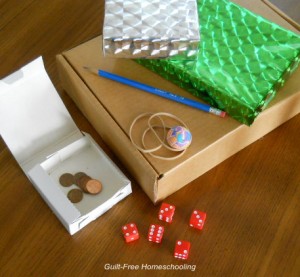In my state it is not legal for me to officially homeschool children who are not members of my immediate family. However, we did sometimes include neighborhood playmates in our activities, particularly in the summertime when “just another day to play” can tend to be somewhat boring. We did not always do formal lessons through the summer, but we did incorporate fascinating, fun, and educational activities into the relaxed playtime of summer.
Summer was a time when I could devote more of my time to planning or preparing a study or activity for later use. I found that I could also give something a “test run” by trying it out on the kiddies — if they enjoyed a taste of it, chances are they would enjoy a more in-depth look during the school year, and perhaps even the children in our larger co-op group would be interested in it, too. So what do you do when your own children are not quite enough for the activity you would like to try out? Let the neighbors join in. Several times, I prepared a fun, yet interesting and educational activity for my own children to do on a boring summer day, only to find that their neighborhood friends were just as interested in breaking the monotony of swinging and bicycling.
Such was the case when I did extensive research and calculations to examine exactly what size an effective solar-system model should be. I have seen many of the science-fair-type of planetary exhibits made from Styrofoam balls, assorted fruits, or sports balls, but I had always felt that I was not seeing an accurate portrayal from those. While my children were spending their summertime swinging, roller-blading, or just relaxing with a novel, I was delightedly poring over scientific facts and punching furiously at my calculator — a welcome change for me from the usual Mom-fare of laundry and dishes. When I finally trooped outside with my notebook of figures, a large measuring tape, and crude signposts mounted on popsicle sticks, my participants were not merely my own offspring, but their eager friends as well, who jumped at the chance to be included in measuring our lawn and placing the markers for each planet’s orbit. Never was one of my summer projects met with an “I already learned that at school” or a “This is vacation — I don’t want to learn anything” response from the children who were not my regular students. Whenever we needed some extra “classmates” for our learning games, there were always ready and eager volunteers.
One day I prepared the “geeWhiz Quiz” for my children, intending it to double as both a math activity and a scavenger hunt. I also secretly hoped that their time spent searching through the game closet would spur some interest in long-forgotten table games and interest them in playing a few of those again. I explained the process of the activity to them while a friend from the neighborhood was present. She seemed deeply disappointed that I expected my children to do this activity later, after she would have returned home. I quickly copied another worksheet for her, and all three children happily spent the entire afternoon in arithmetical computations. My anticipated bonus also paid off: the trio did find several games that piqued their interest, and they kept themselves occupied for many days afterwards.
We often filled our front sidewalk with an extensive Dr. Seuss universe in colored chalk drawings or an ever-expanding circus train overflowing with acrobatic clowns and exotic animals (each new helper got to add his own train car). Our favorite cartoon book illustrations were faithfully copied over and over and over in sidewalk chalk creations. A cleansing overnight rain never brought disappointment, but instead it meant a clean slate for tomorrow. Time after time, the neighborhood children would see us sitting in the middle of the sidewalk and rapidly migrate to our front yard, picking up bits of chalk and asking what parts they could add to the growing mural. My children were not lacking in social contacts with age-mates, and they learned valuable lessons in teamwork and the sharing of ideas as well as supplies.
Being the only homeschool family in your area does not necessarily mean you will not have contacts with other students. We had many opportunities to share educational experiences with public and private school students who were eager to join us in doing things our way. The neighborhood parents knew they could expect our fun activities to have an educational benefit, and their children never seemed to mind it either.




 Guilt-Free Homeschooling is the creation of Carolyn Morrison and her daughter, Jennifer Leonhard. After serious disappointments with public school, Carolyn spent the next 11 years homeschooling her two children, from elementary to high school graduation and college admission. Refusing to force new homeschooling families to re-invent the wheel, Carolyn and Jennifer now share their encouragement, support, tips, and tricks, filling their blog with "all the answers we were looking for as a new-to-homeschooling family" and making this website a valuable resource for parents, not just a daily journal. Guilt-Free Homeschooling -- Equipping Parents for Homeschooling Success!
Guilt-Free Homeschooling is the creation of Carolyn Morrison and her daughter, Jennifer Leonhard. After serious disappointments with public school, Carolyn spent the next 11 years homeschooling her two children, from elementary to high school graduation and college admission. Refusing to force new homeschooling families to re-invent the wheel, Carolyn and Jennifer now share their encouragement, support, tips, and tricks, filling their blog with "all the answers we were looking for as a new-to-homeschooling family" and making this website a valuable resource for parents, not just a daily journal. Guilt-Free Homeschooling -- Equipping Parents for Homeschooling Success!

Recent Comments